Ficus tettensis
Ficus tettensis Hutch.
Family: Moraceae
Common names: small-leaved rock fig (Eng.), kleinblaarrotsvy, klipvy (Afr.), tshikululu (Tshivenda), ibozane, ibozane umkulu, inkiwanyane, umkululu, umpayamputsane (isiNdebele)
SA Tree No: 62
Introduction
The small-leaved rock fig is a rock-splitting tree with an upward growth habit and a rounded crown, hairy leaves, a beautiful yellowish mottled bark and reddish green figs in early summer. It grows on cliffs, rocky outcrops and bedrock in bushveld regions in the Limpopo Province and further north, its stems often plastered over the rock faces.

Fig. 1. Ficus tettensis growing on an east-facing sandstone cliff at Van Coller’s Pass above the Sand River, Soutpansberg. Note the light coloured reflective bark.
Description
Description
Ficus tettensis is a small to medium-sized, ascending branched, slow-growing, winter-deciduous tree with an oblong to rounded crown, usually 4-10 m tall. Seedlings develop an initial carrot-like succulent root embedded in a rock crevice. Bark pale yellowish, grey and flaking, with milky latex when damaged. Young branches grey-green, hairy, 4-6 mm thick. The leaves are egg-shaped (ovate) to broadly egg-shaped, broadly heart-shaped to almost kidney-shaped, 30-100 x 35-110 mm, the base is usually heart-shaped, the blade dull green, leathery and finely hairy. The leaf margin is entire and often wavy. The petiole 10-40 mm, hairy. The leaf tip is rounded and with a short point. The leaf stipules about 5-15 mm long and soon deciduous.

Fig. 2. Close-up of the leaves and stem of a Ficus tettensis on farm Palm Grove, Maremani Nature Reserve. Note the flaking, light coloured, reflective bark and broad, heart-shaped leaves with wavy margins.
The small figs are borne in pairs in the leaf axils, without stalks or shortly stalked, rounded and about 8-11 mm in diameter, somewhat warty and finely hairy (pubescent), light green becoming reddish to reddish-green when ripe. Fruits ripen in spring to summer (Oct. to Nov.).

Fig. 3. Small, finely hairy figs of Ficus tettensis, in pairs in the leaf axils.
Conservation Status
Status
The small-leaved rock fig is widespread and fairly common and, therefore, is assessed as Least Concern (LC) by the Red List of South African Plants.

Fig. 4. A mature tree of Ficus tettensis growing in habitat on top of a rock outcrop on the farm Palm Grove, Maremani Nature Reserve.
Distribution and habitat
Distribution description
Widespread in dry frost-free regions in the lowveld of Limpopo Province in northern South Africa, and further north in Botswana, Zimbabwe, Mozambique, Malawi and Zambia. Its southernmost point is the Olifants River in the southeastern portion of the Limpopo Province. It is always associated with cliffs, boulders and rock outcrops and has been recorded on igneous and sedimentary rock outcrops at altitudes from just above sea level to about 800 m. Seed germinates in crevices and the wandering adventitious roots enables it to establish and form a network of roots.
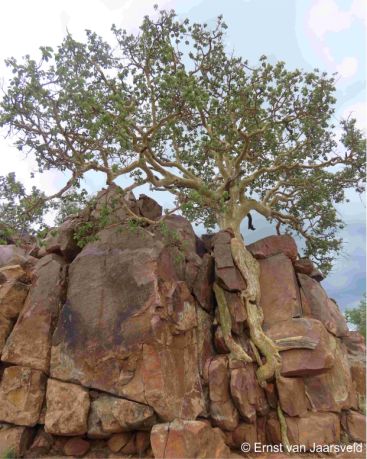
Fig. 5. Ficus tettensis growing on an east-facing sandstone cliff at Van Coller’s Pass above the Sand River, Soutpansberg.
At Van Coller’s Pass above the Sand River in western Soutpansberg, plants were observed growing in Soutpansberg Mountain Bushveld on quarzitic sandstone cliffs and on steep slopes above the Sand River. Other associated figs in its habitat include: Ficus abutilifolia (large-leaved rock fig), F. glumosa (mountain rock fig), F. salicifolia (wonderboom) and F. ingens (red-leaved rock fig). Other trees observed in this rocky habitat are Steganotaenia araliacea (carrot tree), Gyrocarpus americanus subsp. africanus (helicopter tree), Entandrophragma caudatum (wooden banana), Adansonia digitata (baobab) and Ekebergia capensis (Cape ash). On Ga-Hadowe Kop on the farm Palm Grove in Malemani Nature Reserve, plants were observed in Limpopo Ridge Bushveld on a hard meta quarzitic outcrop (Beit Bridge Complex). Here the plants share their habitat with the Sterculia rogersii (star chestnut) and Tinospora fragosa (Aaron’s rod).
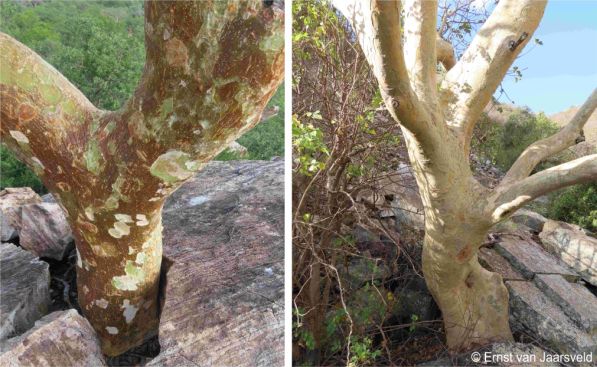
Fig. 6. Close up of the main stem of Ficus tettensis – note the flaking light coloured bark. LEFT farm Palm Grove, Maremani Nature Reserve and RIGHT Abel Erasmus Pass (above tunnel), Limpopo Province.
Along the Olifants Rivier near Penge, Ficus tettensis shares its dolomite cliff habitat with other species such as Adenia fruticosa, Coleus cylindraceus, Coleus neochilus, Coleus hadiensis, Crassula expansa subsp. fragilis, Crassula alba var. pallida, Dracaena transvaalensis, Delosperma vandermerwei, Equilabium dolomiticum, Euphorbia lydenburgensis, Euphorbia tirucallii, Obetia tenax, Orbea hardyi, Aloe branddraaiensis, Aloe hardyi and Kleinia stapeliiformis.
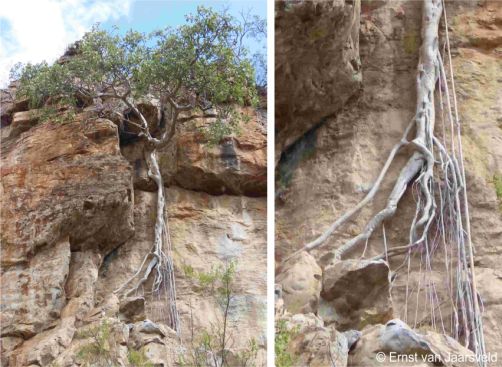
Fig. 7. Ficus tettensis with extensive aerial roots, growing near Penge, on cliffs adjacent to the Olifants River in southeastern Limpopo Province.
Derivation of name and historical aspects
History
Ficus tettensis is one of more or less 8 rock-splitting or petrophilous fig species in South Africa. It was named by the British botanist John Hutchinson (1884-1972) in 1915 from plants collected by John Kirk (1832-1922) in 1858 at Tete in Mozambique. The specific name tettensis, means ‘from Tete’. It is one of 26 indigenous fig species in South Africa and Namibia, andabout 250 in Africa, of which most are trees. In South Africa it was formerly known as Ficus smutsii, named by the botanist Inez Verdoorn (1896-1989) in 1935 from plants collected at Zoutpan by Harold Schweickerdt (1903-1977) and Inez Verdoorn in 1934. She named it after Jan Smuts (1870-1950) who was Prime Minister of South Africa from 1919 to 1924. It was only later realized that the plant was already named and according to the botanical rules of nomenclature, the earliest name takes priority.
Ficus tettensis is related to two other rock splitting figs from the Limpopo Province, with which it often shares its habitat, Ficus abutilifolia (large leaved rock fig) as well as Ficus glumosa (mountain rock fig). Ficus abutilifolia has much larger leaves without hairs and Ficus glumosa has oblong hairy leaves. The broad leaf and wavy margin of Ficus tettensis is very characteristic.

Fig. 8. Close up of a young Ficus tettensis plant occupying a rock crevice, on farm Palm Grove, Maremani Nature Reserve. Note the succulent caudiciform stem with pale reflective bark and the adventitious wandering roots.
Ecology
Ecology
The habitat of Ficus tettensis is warm lowveld bushveld regions and it is exclusively found on cliffs, rock outcrops and bedrock. It has a slow, conservative growth habit. Seed germinates in crevices, especially on cliffs and has the advantage of being out of reach of many herbivores. The seedling first grows a carrot-like succulent base that both anchors the plant and builds up its moisture content, thus allowing for its survival during the dry winter season and periods of drought. The main root from here strategically follows gravity and crevices. The end result is root growth to a length of up to 20 m or longer.
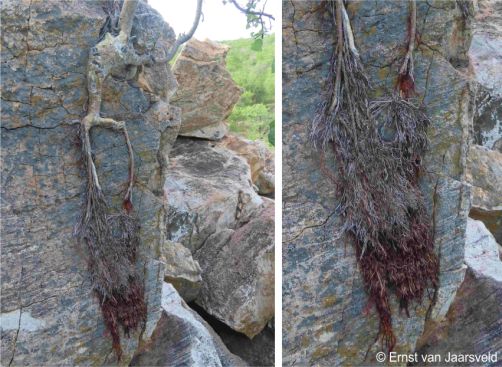
Fig. 9. A specimen of Ficus tettensis growing on rocks on the farm Palm Grove, Maremani Nature Reserve with a mass of adventitious roots reaching down the rock, indicating that this plant is desperately seeking better nutrition.
If the main root is damaged, additional roots will form and take over. The plant also benefits when the wandering adventitious roots penetrate deep crevices where moisture is obtained. Plants benefit from water running down into crevices and to the base of the outcrops where trees take up the extra moisture. Young plants are often victim of regions where the roots cannot reach better ground, and are captured there as a natural bonsai with stunted growth. Roots often form an extensive network over the rocks. Small-leaved rock fig has been recorded from various geological formations such as dolomite, quartz, gneiss, granite and sandstone. Ficus tettensis is pollinated by the minute wasp Nigerriella excavata.

Fig. 10. A naturally stunted, bonsai-like specimen of Ficus tettensis growing on farm Palm Grove, Maremani Nature Reserve.
The relatively small, wavy, leathery and hairy leaves are adaptated to conserve moisture in the very hot, rocky terrain. The light yellow flaking bark of the branches and main stem also efficiently reflects the sun rays.
The figs ripen in spring or early summer and are relished by various local fruit-eating birds and baboons, which disperse the seeds. Leaves are browsed by livestock and local game and smaller animals such as dassies (Procavia capensis).
As with other figs, when branches are damaged the white milky latex that oozes from the damaged parts, seals the wounds.
The stem parasite Viscum menyharthii (fig mistletoe) was observed growing on Ficus tettensis on Ga-Hadowe Kop in the Limpopo Province.

Fig. 11. The fig mistletoe (Viscum menyharthii) a hemi-parasite, growing on Ficus tettensis.
Uses
Use
Ficus tettensis is occasionally propagated and cultivated and used as a bonsai subject.
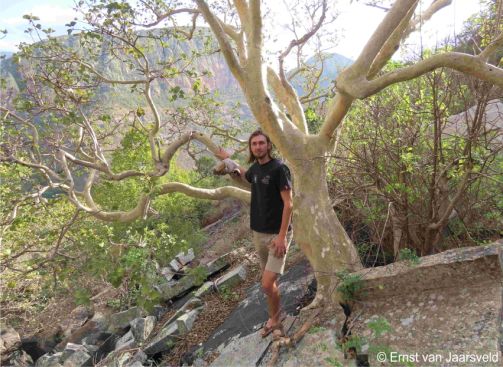
Fig. 12. Ficus tettensis growing above the J.G. Strydom Tunnel on the Abel Erasmus Pass, Limpopo Province, with Cornell Beukes from Babylonstoren Farm providing scale.
Growing Ficus tettensis
Grow
The small-leaved rock fig is well-suited for dry bushveld gardens in areas where frost is absent or not severe. It is a slow grower, and ideal for rock gardens. It has been grown with success in the Botanical Society Conservatory at Kirstenbosch, planted by the author in 1997. The tallest plant today is about 1.5 m. The roots of plants in containers on the raised walkway have penetrated from the bottom and grown down the concrete walls attempting to reach the soil level. Ficus tettensis is also ideal for bonsai culture, the light greenish-yellow to pale grey stems, adventitious roots and small leaves are very decorative.
Propagation is from seed or cuttings. Crush the dried fruits and sow in spring or summer in shallow trays. Cover with a thin layer of sand (1-2 mm thick) and keep moist. Germination is rapid with viable seed, and the figs initially grow quite fast. Plant out when large enough to handle.
Vegetative propagation is achieved by either semi-hardwood, hardwood or pole cuttings. Semi-hardwood cuttings of about 10-15 cm length can be taken during summer. Remove the leaves on the lower half of the stems and plant in a mixture of polystyrene and peat. Rooting in a hot bed is within 2-3 weeks. Pole cuttings can be a side branch of the tree. Plant half of its length in a hole well prepared with a sandy mixture, to which compost and be added. Best results are obtained in late winter or spring. Keep moist.
Ficus tettensis is susceptible to eel worm.
References
- Burrows, J. & Burrows, S. 2003. Figs of southern and south-central Africa. Umdaus Press, Hatfield.
- Clarke, H. & Charters, M. 2016. The illustrated dictionary of southern African plant names. Flora & Fauna Publications Trust, Jacana, Johannesburg.
- Coates Palgrave, M. 2005. Keith Coates Palgrave trees of southern Africa edition 3. Struik, Cape Town.
- Lotter, J.de V. 2012. The fig in South Africa. Western Cape Department of Agriculture, Cape Town.
- Palmer, E. & Pitman, N. 1972. Trees of southern Africa. Balkema, Cape Town.
- Raimondo, D., Von Staden, L., Foden, W., Victor, J.E., Helme, N.A., Turner, R.C., Kamundi, D.A. & Manyama, P.A. (eds) 2009. Red list of South African plants. Strelitzia 25. South African National Biodiversity Institute, Pretoria.
- Van Jaarsveld, E.J. 1983. The cultivation and uses of South African Figs. Trees in South Africa. Vol 34: 63–78.
- Van Wyk, B. & Van Wyk, P. 2013. Field guide to trees of southern Africa. Struik Publishers, Cape Town, Johannesburg.
- Venter, J. & Beukes, G.J. 1989. ‘N reuse Namakwavy. Journal of Dendrology 12: 25–26.
- Wienand, N. 2025. Observation of Ficus tettensis. Vhembe District, Limpopo. iNaturalist. Online. https://www.inaturalist.org/observations/267311256.
- Wijnands, D.O., Wilson, M.L. & Toussaint van Hove, T. Jan Commelin’s Monograph on Cape Flora. University of Stellenbosch Printers, Stellenbosch.
- Wursten, B. 2015. Observation of Ficus tettensis, Chipinge, Zimbabwe. iNaturalist. Online. https://www.inaturalist.org/observations/188422015.
Credits
Ernst van Jaarsveld
Kirstenbosch National Botanical Garden (Retired)
Babylonstoren Farm (Current)
Extraordinary senior lecturer and researcher,
Department of Biodiversity and Conservation, University of the Western Cape
May 2025
Acknowledgements: the author thanks Bart Wursten and Nicole Wienand for sharing their observations of the fruits of Ficus tettensis on iNaturalist.
Plant Attributes:
Plant Type: Shrub, Tree
SA Distribution: Limpopo
Soil type: Sandy, Loam
Flowering season: Spring
PH: Acid, Alkaline, Neutral
Flower colour: Green, Red
Aspect: Full Sun
Gardening skill: Average
Special Features:
Horticultural zones








Rate this article
Article well written and informative
Rate this plant
Is this an interesting plant?
Login to add your Comment
Back to topNot registered yet? Click here to register.